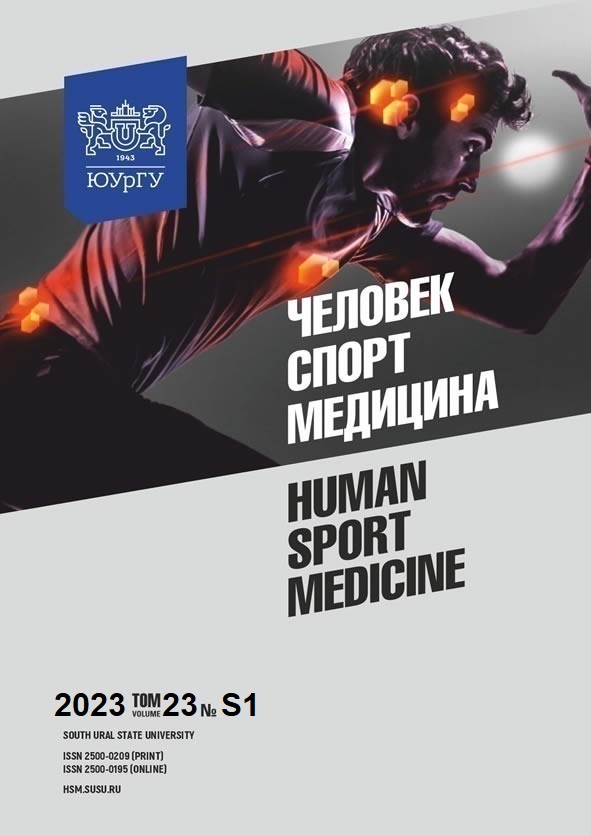ОСОБЕННОСТИ ПОСТУРАЛЬНОЙ УСТОЙЧИВОСТИ СПОРТСМЕНОВ-БАДМИНТОНИСТОВ ПОСЛЕ ФУНКЦИОНАЛЬНОЙ НАГРУЗКИ
Аннотация
Цель: оценить смещения центра давления во время выполнения спокойной стойки в пробе Ромберга и относительно сложной задачи в тесте «Мишень» до и после выполнения нагрузочного теста у квалифицированных спортсменов-бадминтонистов и неспортсменов. Материалы и методы. Для оценки постуральной устойчивости проводился тест «Допусковый контроль» до и после функциональной нагрузки (45 приседаний за 1 минуту) на компьютерном стабилоанализаторе. Анализировались такие стабилометрические показатели, как: качество функции равновесия, средняя линейная скорость колебания центра давления, среднее значение линейной скорости смещения центра давления, среднеквадратическое отклонение центра давления во фронтальной и сагиттальной плоскостях, площадь эллипса, включающего 90 % точек статокинезиограммы. Результаты. Качество функции равновесия снижалось у всех участников в пробе с закрытыми глазами и тесте «Мишень», причем у спортсменов-бадминтонистов в пробе с закрытыми глазами постуральная устойчивость была снижена больше. Функциональная нагрузка приводила к ухудшению постурального баланса у неспортсменов, отмечалась замена голеностопной стратегии на тазобедренную при поддержании равновесия. В тесте «Мишень» спортсмены-бадминтонисты продемонстрировали высокую продуктивность, показали высокий результат при эффективной стратегии удержания центра тяжести в заданной зоне. Заключение. Спортсмены-бадминтонисты имеют различия в постуральном контроле по сравнению с неспортсменами. Зрительный анализатор является ведущим в поддержании постурального баланса у бадминтонистов. Cложившаяся активная нервно-мышечная регуляция позы в результате тренировок у спортсменов приводит к стабилизации в сагиттальной плоскости при усложнении постуральных задач.
Литература
2. Dos’Santos T., Thomas C., McBurnie A. et al. Biomechanical Determinants of Performance and Injury Risk During Cutting: A Performance-Injury Conflict? Sports Medicine, 2021, vol. 51, no. 9, pp. 1983–1998. DOI: 10.1007/s40279-021-01448-3
3. Fernández-Rio J., Santos L., Fernández-García B. et al. Effects of Slackline Training on Acceleration, Agility, Jump Performance and Postural Control in Youth Soccer Players. Journal of Human Kinetics, 2019, vol. 67, pp. 235–245. DOI: 10.2478/hukin-2018-0078
4. Guermont H., Le Van pp., Marcelli C. et al. Epidemiology of Injuries in Elite Badminton Players: A Prospective Study. Clinical Journal of Sport Medicine, 2021, vol. 31, no. 6, art. e473–e475. DOI: 10.1097/JSM.0000000000000848
5. Paillard T. Plasticity of the Postural Function to Sport and/or Motor Experience. Neuroscience & Biobehavioral Reviews, 2017, vol. 72, pp. 129–152. DOI: 10.1016/j.neubiorev.2016.11.015
6. Paillard T., Noe F. Techniques and Methods for Testing the Postural Function in Healthy and Pathological Subjects. BioMed Research International, 2015, vol. 2015, art. 891390. DOI: 10.1155/ 2015/891390
7. Faude O., Meyer T., Rosenberger F. et al. Physiological Characteristics of Badminton Match Play. European Journal of Applied Physiology, 2007, vol. 100, pp. 479–85. DOI: 10.1007/s00421-007-0441-8
8. Bouagina R., Padulo J., Fray A. et al. Short-Term in-Season Ballistic Training Improves Power, Muscle Volume and Throwing Velocity in Junior Handball Players. A Randomized Control Trials. Biology of Sport, 2022, vol. 39, no. 2, pp. 415–426. DOI: 10.5114/biolsport.2022.106150
9. Lu Z., Zhou L., Gong W. et al. The Effect of 6-Week Combined Balance and Plyometric Training on Dynamic Balance and Quickness Performance of Elite Badminton Players. International Journal of Environmental Research and Public Health, 2022, vol. 19, no. 3, art. 1605. DOI: 10.3390/ijerph19031605
10. Zemková E., Zapletalová L. The Role of Neuromuscular Control of Postural and Core Stability in Functional Movement and Athlete Performance. Frontiers in Physiology, 2022, vol. 13, art 796097. DOI: 10.3389/fphys.2022.796097
References
1. Kang S.H., Kim C.W., Kim Y.I. et al. Alterations of Muscular Strength and Left and Right Limb Balance in Weightlifters After an 8-week Balance Training Program. The Journal of Physical Therapy Science, 2013, vol. 25, no. 7, pp. 895–900. DOI: 10.1589/jpts.25.8952. Dos’Santos T., Thomas C., McBurnie A. et al. Biomechanical Determinants of Performance and Injury Risk During Cutting: A Performance-Injury Conflict? Sports Medicine, 2021, vol. 51, no. 9, pp. 1983–1998. DOI: 10.1007/s40279-021-01448-3
3. Fernández-Rio J., Santos L., Fernández-García B. et al. Effects of Slackline Training on Acceleration, Agility, Jump Performance and Postural Control in Youth Soccer Players. Journal of Human Kinetics, 2019, vol. 67, pp. 235–245. DOI: 10.2478/hukin-2018-0078
4. Guermont H., Le Van pp., Marcelli C. et al. Epidemiology of Injuries in Elite Badminton Players: A Prospective Study. Clinical Journal of Sport Medicine, 2021, vol. 31, no. 6, art. e473–e475. DOI: 10.1097/JSM.0000000000000848
5. Paillard T. Plasticity of the Postural Function to Sport and/or Motor Experience. Neuroscience & Biobehavioral Reviews, 2017, vol. 72, pp. 129–152. DOI: 10.1016/j.neubiorev.2016.11.015
6. Paillard T., Noe F. Techniques and Methods for Testing the Postural Function in Healthy and Pathological Subjects. BioMed Research International, 2015, vol. 2015, art. 891390. DOI: 10.1155/ 2015/891390
7. Faude O., Meyer T., Rosenberger F. et al. Physiological Characteristics of Badminton Match Play. European Journal of Applied Physiology, 2007, vol. 100, pp. 479–85. DOI: 10.1007/s00421-007-0441-8
8. Bouagina R., Padulo J., Fray A. et al. Short-Term in-Season Ballistic Training Improves Power, Muscle Volume and Throwing Velocity in Junior Handball Players. A Randomized Control Trials. Biology of Sport, 2022, vol. 39, no. 2, pp. 415–426. DOI: 10.5114/biolsport.2022.106150
9. Lu Z., Zhou L., Gong W. et al. The Effect of 6-Week Combined Balance and Plyometric Training on Dynamic Balance and Quickness Performance of Elite Badminton Players. International Journal of Environmental Research and Public Health, 2022, vol. 19, no. 3, art. 1605. DOI: 10.3390/ijerph19031605
10. Zemková E., Zapletalová L. The Role of Neuromuscular Control of Postural and Core Stability in Functional Movement and Athlete Performance. Frontiers in Physiology, 2022, vol. 13, art 796097. DOI: 10.3389/fphys.2022.796097
Copyright (c) 2023 Человек. Спорт. Медицина

Это произведение доступно по лицензии Creative Commons «Attribution-NonCommercial-NoDerivatives» («Атрибуция — Некоммерческое использование — Без производных произведений») 4.0 Всемирная.















